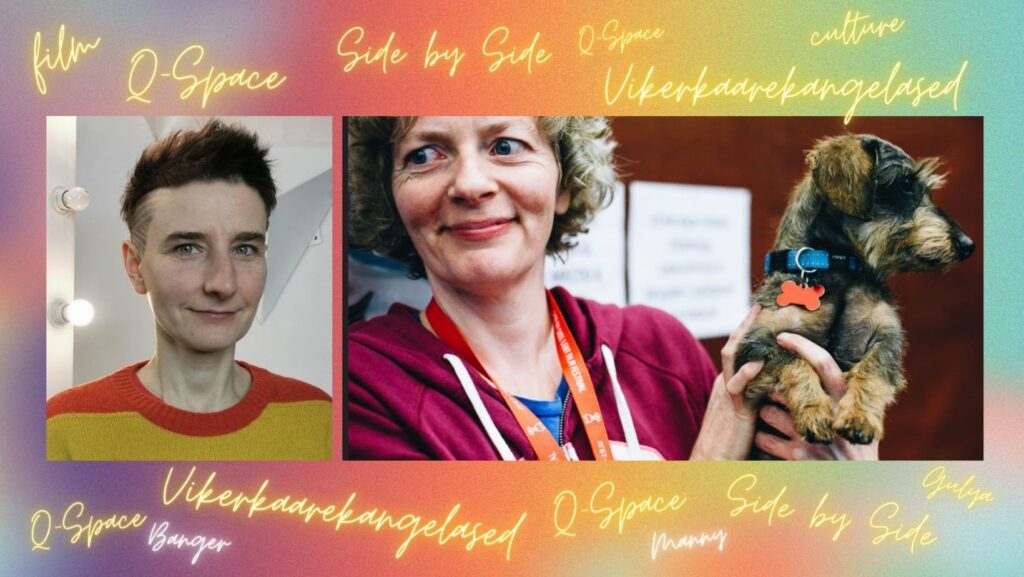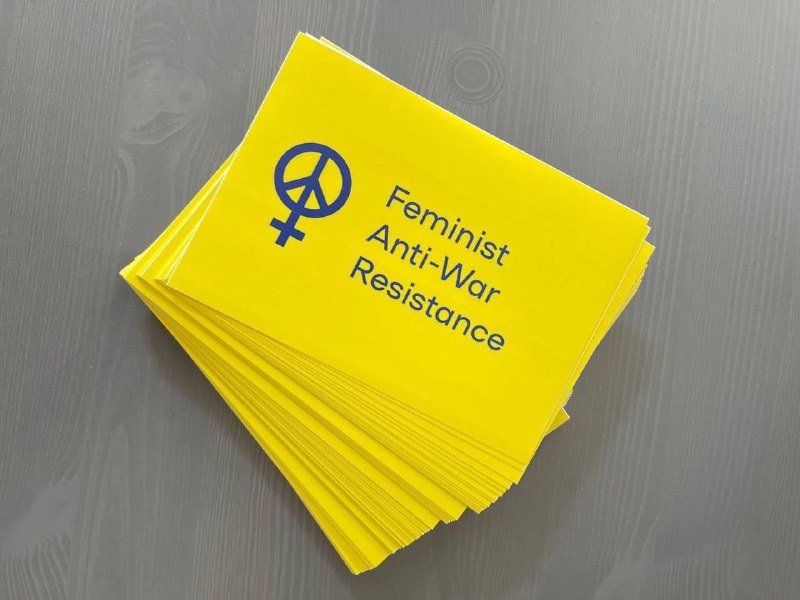The analysis of Syrian uprising is still missing a fundamental element: the grassroots level
Do experts have a sufficiently comprehensive knowledge of the Syrian revolution or is there something important that is missing from the overall discussion? “The Syrian revolution was stripped of its agency when the world began to call it a civil war, as befitted Syrian dictator Bashar al-Assad,” says Syrian-Palestinian activist Razan Ghazzawi in an interview with Feministeerium. Ghazzawi reminds us that she has witnessed a failure of recognising multiple agencies involved in the revolution – especially those of the most marginalised – thus telling a more complex story about the revolution. Razan offers us a glimpse of what it means to see the Syrian revolution from a queer feminist perspective.

Razan Ghazzawi (they/she) is a Syrian-Palestinian blogger, campaigner, activist, and scholar. They received their PhD in Gender and Sexuality Studies from the University of Sussex, Brighton. In their thesis “Pedagogies of Everyday Queer Protests: Rethinking Political Subjectivity and Violence in Syria and Lebanon 2011-2021,” they examine everyday queer and trans encounters at checkpoints, prisons, and queer asylum in the contexts of “war on terror” and the “refugee crisis.” Razan is a EUME Fellow in the academic year 2022/23. They are a former prisoner from the Syrian state and an award winner of Frontline Defender in 2012
The Syrian revolution1 began more than 10 years ago. Please share your views on what triggered it? To add an intersectional aspect to it – what were differently positioned women’s & other marginalised groups’ grievances?
It is important to see the popular protests in Syria in the context of the North Africa and Southwest region (NASWA). The revolutions in Tunisia and Egypt triggered the Syrian revolution, showing the people in Syria another way to live, to protest. Seeing people in the region protesting military postcolonial authoritarian states triggered the revolution. People in Syria (citizens, stateless, migrants, refugees) saw that it was possible to also protest against “everlasting leaders” as Hafez Assad2 had framed himself since the 80s.
There are many reasons behind the popular protests in Syria: they are class-based, related to lack of freedom of speech, poverty, unemployment for generations of youth graduating each year. Also, neoliberal policies introduced by Bashar Assad further marginalized the suburbs and benefited the Sunni Arab upper-class and businessmen in Damascus, Aleppo, and Homs. Bashar Assad maintained his father’s nepotism economy, which further strengthened the army and the security forces regimes and accommodated the businessmen class in major cities with neoliberal policies. This merger between nepotism practices and neoliberal policies meant more difficulties for people without jobs or a stable income, chronically ill, and especially women, stateless people, migrant workers, or LGBTQ people, among others.
So it was not a coincidence to find many ‘ordinary’ people join the popular protests: students, workers, and stateless communities. Women, minorities, Kurds, and LGBTQ people were at the forefront of the grassroots movement and its leadership. This is new since previously many opposition parties and collectives, whether they were leftist or Islamist, were mostly led by middle-class leftist men. The protest movement was grassroots because it was not elitist, it was grassroots, and everyone was part of it if they were in Syria. This opportunity to invest in grassroots leadership would have been a great way how the diaspora opposition or civil society could have supported the revolution.
Would you describe the situation in Syria today? What about those in exile?
It’s hard to answer this question as I don’t think I’ll be able to give justice to many issues at stake. But as a community-educator and lecturer, I tell my students that Syria is a story of co-optation. By co-optation I mean the NGOized and diaspora co-optation of the grassroots struggles and protests. The revolution was carried out by the labour and sweat of those who were on the ground, but had to leave the country and survive Europe’s closure of borders and asylum regimes, precarity of jobs and livelihoods, etc. This paved the way for a change in who could represent the revolution. Therefore, the revolution overwhelmingly became represented by the NGOized movement, who were mostly diaspora figures with liberal notions on protest and political dissent. This is why you have seen more representation of CEOs and middle-upper class diaspora Syrians with little grassroots politics than protesters of the movements themselves. Instead of uplifting those on the ground, the diaspora movement took a right-wing direction and supported the idea of sanctions and continued militarization as the only way for emancipation. Since they had more access – with foreign passports, location in diaspora and exile, as well as the social capital of speaking foreign languages – the diaspora movement mobilized western states to enforce a military approach to end the conflict – which is what Assad and his allies know best as an authoritarian military state.
It is important to remind the readers that the people’s grassroots and popular movement was first co-opted by the Syrian state authoritarianism and its allies who used checkpoints, prisons, torture, field assassinations, the bombardment of cities and neighbourhoods, and uprooting and displacing dissident communities and those who hosted them to crush the popular protests. But it is also the diaspora liberal opposition and many in the civil society movement, researchers, editors, and writers on the left and even feminists, who justified collaboration with problematic states like Saudi Arabia, Qatar, United Arab Emirates, Turkey, and even Israel, to topple the Baathist regime, or were silent about those making these ties.
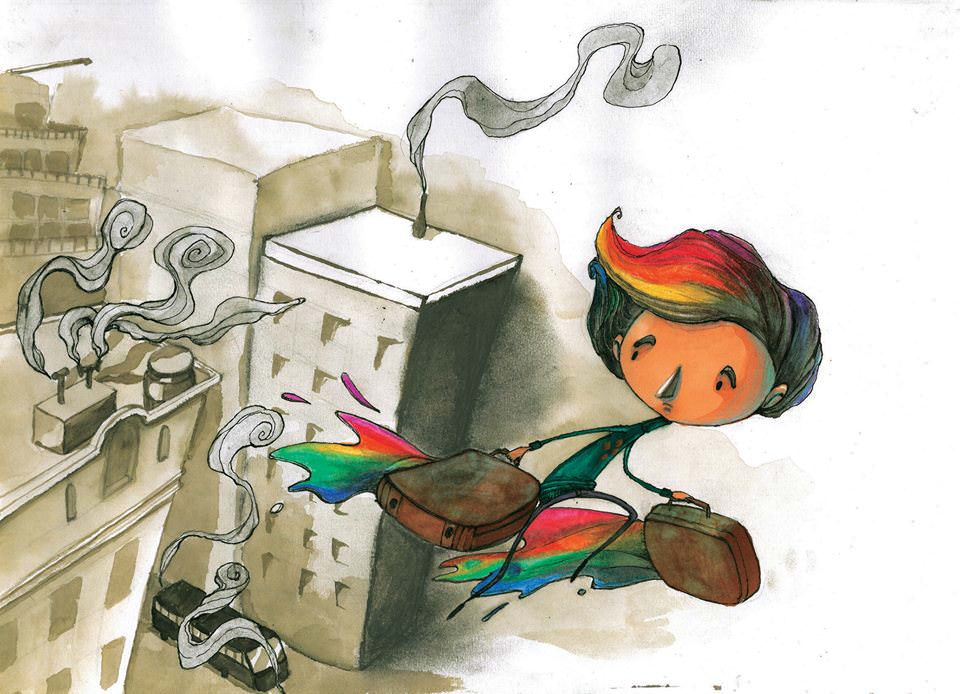
Illustrations by activist-artist Diala Brisly. Downloaded with the permission of the author from the page preserving the works of Syrian artists https://creativememory.org/ Diala’s works can be viewed on her official artist FB page @dialabrisly
How did this impact the course of things in Syria?
This liberal approach and revolutionary politics proved harmful for the grassroots revolution because their politics was complicit in the hate and silence towards the Syrian Kurds (Arab racism), who are occupied and uprooted by Turkey and its proxy Syrian Arab armed groups. Unfortunately, Turkey and some Syrian Arab opposition and civil society groups are damaging the solidarity ties between Arab and Kurdish communities that had been cultivated by the 2011 Syrian grassroots movement. Unfortunately, Syrian feminists have not condemned this liberal politics, but were focused on portraying Syrian women as wives and mothers of detainees, rather than detainees and protesters themselves. Many Syrian CEO feminists still defend militarization as representative of ‘people’s demands,’ but these CEO feminists were not on the ground to begin with to assess what the people wanted. Yes, some activists wanted militarization, but families and ‘ordinary’ Syria were not supportive of militarization. This is why grassroots feminism is different from diaspora and CEO feminism. This is what I mean by co-optation of the revolution; it’s a co-optation from the state and uncritical liberal diaspora through the NGOization of the movement.
Razan, already in the early years of the Syrian revolution you were writing about the fact that women’s voices were left out of the stories told of the Syrian revolution. Are women’s voices more prominently represented nowadays in diverse accounts of the Syrian revolution?
My earlier writings focused on grassroots women activists who were protesting and organizing on the ground. I also wrote about the families and communities I worked with on the ground in Damascus, Damascus suburbs, Yarmouk Camp, Latakia suburbs, and Idlib. Yes, I wrote that women and nonbinary people on the ground are not represented, and I still argue this is the case. Today’s representation is mostly dominated by the middle-upper class diaspora with decision-making capabilities or CEO positions. The grassroots protesters have been silenced, erased, and excluded from today’s representation.
What are the platforms they use?
Their platform is Syria. They worked with their communities on the ground, so they are not very visible or accessible via work emails and international meetings and platforms, nor do they have access to visas or international platforms like people in diaspora or exile. There are many women whose activism included care, distributing aid, breaking sieges, delivering medicine, and smuggling wanted men outside of besieged neighborhoods- in short, the revolution was maintained by women’s labour as well as by women activists from minority background, the stateless Palestinians, and LGBTQ people – without whom the revolution would not be possible, or maintained. These are not civil society managers or researchers. They’re grassroots organizers, workers, media journalists, smuggler women, and nurses. And yes, the NGOized movement is currently visible due to the strong relationship between representation, access, and capital. What’s left are the grassroots, especially women, femmes, and trans women.
Which stories are we still not hearing?
I have mentioned some in my answer above, but I can also add the laborers. The undercommons. Protesters who are the ‘ordinary’ Syrians. The refugees, the migrant workers, or the Ramadyeen’s; I wrote about Ramadyeen’s protest in one of my recent articles. It’s open access if people want to see it. The Ramadyeen, or the Grey People, is originally a term used to describe people in Syria whose politics is not revolutionary enough. In my article, I document how the meaning of this term shifted and attacked revolutionaries who do not conform to dominant right-wing demands such as continued militarization, sanctions, and allying with the USA and Turkey. Syrian Kurds’ stories on the ground are not heard, those are called by Arab Syrians the ‘separatists.’
These terminologies, as I argue in my article mentioned above, are designed to silence minority and non-normative revolutionary thought and politics by the Arab Sunni majority. So it is safe to argue that those who are silenced and bullied are those who are not heard.
You have said that those feminists who identified as anti-militarists were under open attack from different sides. Who were the ones opposing these more complex positions? Can you re-iterate why this was the case? What other identities and forms of protests were ignored in the so-called revolutionary discourse? Why does this matter?
The revolution in Syria started as a nonviolent movement. What does it mean when we say that? It means that ‘ordinary’ people were the leaders: taxi drivers, construction workers, migrants, students, refugees, mothers, children, and the unemployed. All of these communities had taken to the streets marching, writing, giving aid, or care, crossing checkpoints and smuggling aid into besieged neighbourhoods. All these kinds of labour produced what we talk about as protest, which sustained and maintained the popular protests for years. So protest is a form of material labour3 many exiled and diaspora leftists don’t talk about. A strong phase of ‘Silmyyeh’ (peaceful protests) was dominant in 2011 and 2012, even in later years in some parts of Syria like Al Souweidaa, for example.
The regime’s ‘war on terror’ against peaceful protesters started with checkpoints, raids, torture, and mass incarceration and developed into bombardment, chemical weapons, and hunger besieges. Many among the Syrian diaspora politicians, liberal or Muslim Brotherhood4 groups, saw an opportunity to have control on the ground through military proxy groups. This happened while some military officers and soldiers were defecting from the state’s military after committing crimes against protesters and villages. This is how the Free Syrian Army (FSA) was formed. But the Muslim Brotherhood, man liberal politicians in the US and Europe, saw an opportunity to be part of the political movement in Syria by military means. Unfortunately, the regime turned this into a question of sovereignty and ignored Syrian’s lives and dreams.
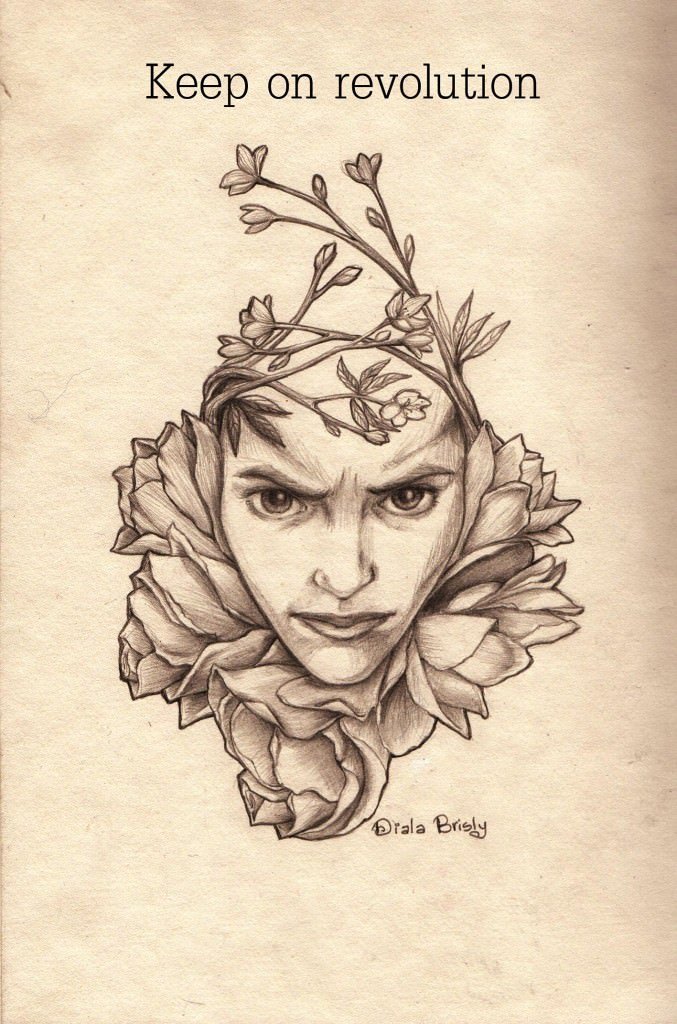
Illustrations by activist-artist Diala Brisly. Downloaded with the permission of the author from the page preserving the works of Syrian artists https://creativememory.org/ Diala’s works can be viewed on her official artist FB page @dialabrisly
But this phase produced a Syrian consciousness that is pro-military. Being pro-FSA is the norm in the revolution. It is a dominant demand to use military methods to topple the regime in Syria. While opposition and activists still living in Syria disagree, many in exile and diaspora believe pro-militarization is synonymous with the revolution in Syria. To not be pro-militarization means you’re an Assadist and complicit in Assad’s crimes.
While many in Syria are against militarization, it is the anti-military feminists, the religious and ethnic minorities, and the LGBTQ community who have been bullied, attacked, and discredited by the movement as ‘Assadists’ when expressing these anti-militarist views even though these are the views of the ordinary. It’s the political elite alone, including civil society, that is supportive today of sanctions and military solutions. Again, this is why we need to talk about NGO co-optation of the grassroots revolt.
Since the beginning of the revolution, you and many other women led feminist initiatives (e.g., mutual aid works, educational initiatives, like the Karama bus project, which offered psychosocial support to Syrian kids, weekly prison visits) that actually amounted to the needed care work for a movement. Yet these various initiatives were not always recognised or talked about. Can you reflect on the diversity of these initiatives and why they are essentially feminist and vital for the revolution?
These are forms of grassroots work that have been produced by the people on the ground, community activists and leaders. It was not a project proposal that was written in Gaziantep, Berlin, Paris, or Washington DC. This is important because this is how community is formed and the creation of alternative realities and imagining alternative futures. As I mentioned earlier, the protests started as ‘ordinary’. When thinking about diversity, I think about class, gender, sexuality, religion/confessional community, and political views.
However, today’s representations of the revolution are not diverse, they’re more professional researchers, CEOs, and experts. Also, there’s a new class of researchers today, most of whom have no ties to the ground or the revolution.
I am a researcher and a postdoctoral fellow today, and it’s rare to find researchers who’ve been on the ground and bringing their activism to their research among researchers in the diaspora today. This creation of the political elite in the diaspora, while the grassroots is forgotten, is perhaps the biggest missed opportunity ever by the opposition in the diaspora and exiled revolutionaries.
Grassroots organizing that is abolitionist5, like the prison visits or based on teaching children deprived of learning, like Karama Bus project, are all projects that were reproduced by grassroots activists who were in prison and understood the prisoners’ struggle.
Activism is feminist if it pays attention to people’s class and gender struggle and methods of exclusion from the state and revolutionary circles and would not privilege only some women and solutions (CEOs, pro-militarization, and pro-sanction), over grassroots organizers and activists.
Not all civil society work is essentially feminist. I understand feminism as a school of thought that challenges all sorts of authority, whether it is capital, state, military, sanctions, counterrevolutionary, racism, and co-optation of struggle. Unfortunately, a lot of Syrian feminists today call for sanctions and military solutions as a solution to end the war on Syria. This is why there is an urgent need for a grassroots approach to feminism in Syria, and this cannot happen from the diaspora.
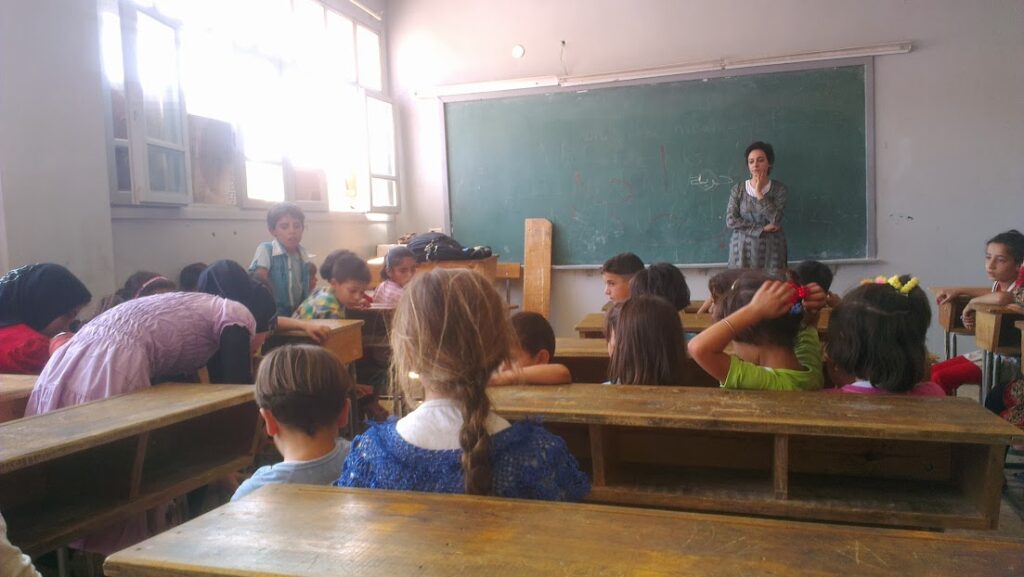
Razan Ghazzawi teaching the children of the Karama Bus Project in Syria. Photo: Razan Ghazzawi private collection
At one point you were detained and taken to one of the prisons. If you can travel back to this time, mainly to the conversations you had with women in the prison, how did this impact you and what did you learn and take from this experience?
I am very sorry but I’m not comfortable talking about my prison experience and I would be careful to get consent upfront from former prisoners before including questions about their prison experiences.
Your piece in Kohl journal’s special issue on Anticolonial Feminist Imaginaries offers piercing criticism of both imperial violence (colonial moment of the now) and the postcolonial state’s (Assad’s) violence in the context of the Syrian revolution. In a nutshell- what are the characteristics of the two and what impact this has had on women?
The article talks about the politics of co-optation and weaponization of the Palestinian and Jawlani (Syrians in Jawlan/Golan) struggles for self-determination and liberation on the part of Syrian state officials as a way of justifying their mass human rights violations since the uprising in Syria. In the article Dr Nayrouz Abu Hatoum and I identify the discursive machine the Syrian regime manufactured as a form of whitewashing. In doing so, we reject the Syrian regime’s argument that it acts as an anti-imperialist and anti-Zionist resistance force in the region. According to the regime’s definition of resistance to anti-imperialism, any popular, grassroots, or out-of-state struggles against the regime in Syria are inherently imperialist and supportive or complicit with Zionism. Instead, we foreground our analysis by looking at the occupied Jawlan and the Palestinian camps in Syria during and after the Syrian uprising that redefines and claims back sumoud outside of the Syrian state’s definition. We critique the state’s claims by proposing to name such state-led propaganda as sumoud-washing. By Sumoud, we mean the steadfastness of Palestinians and Jawlanis against Israeli colonialism.
Can you say why treating violence in a more complex manner matters in the context of the Syrian revolution? What can feminists learn from you and this writing?
Violence in Syria has been understood mainly through a heteronormative6 lens: noticing how fathers, mothers were targeted but no discussion of violence targeting gender nonconforming people or communities who do not belong to majoritarian Arab Sunnis. Majoritarian lens can never bring justice to people, because it only tailors to Sunni Arabs in Syria. Revolutionary justice should recognise every one, all people, and should address not just Assad, but the counter revolution that majoritarian Sunni don’t want to talk about.
Feminists can learn that the Syrian social movement exposed the coloniality of a lot of so-called imperial states and global left that have little relations and connections to land, waters, and people in Syria, and they are more concerned with the logic of dictator sovereignty. The Syria example tells us we cannot understand the revolution in Syria without going back to the question of Palestine, care, and violence in a non-heteronormative and non-homonormative way.

From left: Razan Ghazzawi, artist Diala Brisly and Birgit Poopuu at a conference in London. Photo: Birgit Poopuu
If you would like to extend some knowledge as a revolutionary feminist to Ukrainian women then what would you say to them?
I want to extend my solidarity to the rebelling communities worldwide and in Ukraine to the trapped refugees on European borders, and the unemployed stateless migrants, the incarcerated carers and the excluded, demonized queer feminist killjoys, and fearless feminist protesters in Iran, Sudan, Bahrain, Palestine, Ukraine, and anti-Erdogan feminists in Turkey.
I believe in mutual solidarity and knowledge between feminists. I believe Ukrainian feminists can learn from Syrian and Palestinian feminists in Syria about the question of Palestine. States who normalize relations with the settler colonial state of Israel or perform animosity towards it are both problematic stances. Syrian Palestinians show how they are uprooted and colonized by Israel and also uprooted and massacred by Syria. This lesson is something that many feminist movements can learn about the intersection of nation, nationalism, revolution, and feminism.

Illustrations by activist-artist Diala Brisly. Downloaded with the permission of the author from the page preserving the works of Syrian artists https://creativememory.org/ Diala’s works can be viewed on her official artist FB page @dialabrisly
Of the future of Syria. Regionally, there seems to be a tendency that governments in MENA are starting to accept that al Assad is there to stay. What does this mean for Syria, and its diverse population in the country and abroad? What about women and minorities?
I am a Syrian Palestinian grassroots queer nonbinary feminist organizer in Syria and Lebanon since 2005, when I started my blog Decentering Damascus. I and many others used to write against Assad six years before the revolution began. Having Assad in power did not stop us back then, and it will not stop people and the youth from protesting now or in the future. I believe in people more than I believe in the international community or in diasporic military solutions of sanctions to gain emancipation. There is no such thing as emancipation with military means. These methods of impeaching governments and dictators have proven harmful for decades in many countries in the global south. I am a people’s movement person and I think the diaspora should join people’s movement on the ground and not create a counter-revolution from afar, like sanctions. What does this mean for Syria and minorities? A long struggle. A very long one. But emancipation is about the means, not the ends. This is also a long feminist lesson.
- Syrian activists often use the words uprising and revolution interchangeably, we also mean the same thing by revolution and uprising. – HH & BP
- Hafez al-Assad was a Syrian general. He seized power in Syria in a military coup and was president from 1971 until his death in 2000. He is the father of Bashar al Assad – HH & BP
- Protest as material labour in the context of revolutions means that ordinary people create parallel societies and institutions. In Syria, activists created hospitals, schools, shelters, electricity and water distribution infrastructures, community radios, engaged in citizen journalism, etc
- The Syrian Muslim Brotherhood was founded in the mid-1940s by Mustafa al-Siba’i and Muhammad al-Mubarak al-Tayyib, who were friends and colleagues of Hassan al-Banna, the founder of the Egyptian Muslim Brotherhood. At the beginning of independence, the Syrian Muslim Brotherhood was part of the legal opposition and won ten seats in the 1961 parliamentary elections. After the 1963 coup that brought the secular pan-Arab Ba’ath Party to power, the Brotherhood was banned. From there, the Brotherhood played an important role in the mainly Sunni resistance movement. Read more: Conduit, Dara. (2019) The Muslim Brotherhood in Syria. Cambridge: Cambridge University Press. – HH & BP
- Abolitionism, in this context, is a practice that deals with dismantling oppressive structures and creating so-called alternative and decent realities. Examples in this context can be prison visits or teaching out-of-school children, such as the Karama bus project. Read more of the works of, for example, Angela Davis and Ruth Wilson Gilmore, BP
- Read more about heteronormative and homonormative ideologies in Jasbir Puar’s work, e.g., Terrorist Assemblages: Homonationalism in Queer Times





